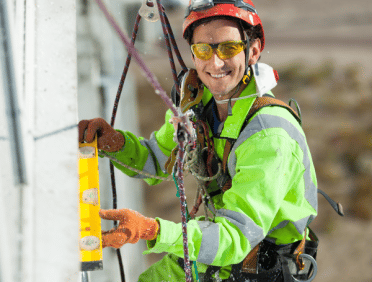What is Asbestos?
Asbestos is a term that you may have heard of, but you may not be entirely sure what it is and what it can do. This blog post is there to help you to work out more about asbestos, what it can be used for and what can happen if you are exposed to it.
Definition and types of asbestos
Asbestos is made up of six unique minerals.
Asbestos is usually put into two groups; serpentine asbestos and amphiboles asbestos. Serpentine asbestos is usually known as white asbestos and is the type of asbestos that you are most likely to see used in the UK.
It was used more commonly because it is soft and flexible. It is also the less hazardous type of asbestos compared to amphibole asbestos.
Historical usage of asbestos in the UK
Asbestos has been around in the UK since the 1870s when it was first used. At this time it was usually seen used on ships, steam engines and in power generating plants. By the 1930s asbestos was starting to be used in a variety of building materials.
The biggest boom for asbestos in building materials came in the 1960s when it was also used in household products too, to provide them with heat resistance.
Early in the 1900s, it was discovered that asbestos could be dangerous to humans, however, it was not until the late 1900s that it was banned in the UK.
Common locations where asbestos can be found
There are lots of places where you may find asbestos. It can be a part of a sprayed coating that is sprayed on steelwork to protect it from fire, or on the underside of roofs. It can also be used mixed with cement, which will then end up in roof panels, wall cladding, gutters, flues and pipework.
You may also find asbestos in loose-fill insulation, such as the insulation that you will find in cavity walls and roof spaces. It is also seen in lagging heating systems and even in heat-resistant blankets and gloves too.
This is one of the biggest issues when it comes to asbestos, the amount of places that you can find it in and the many uses that it had.
Health Risks Associated with Asbestos Exposure
As we have mentioned, in the early 1900s it was identified that asbestos can be harmful to those who are exposed to it. The fibres are breathed in when the asbestos is damaged or moved and this is what ends up in the respiratory system of the person.
There are a variety of respiratory diseases that can be caused by asbestos. Some of which can prove to be fatal.
Asbestosis
Asbestosis is a long-term lung condition that is caused by prolonged exposure to asbestos. No treatment can reverse the damage that asbestos causes, however, with asbestosis, there is a range of treatments out there that can slow down the progression of the disease and that can help to relieve some of the symptoms that you may feel.
Lung cancer
Lung cancer can be caused by a variety of things, however, one way that you can start to develop cancerous cells in your lungs is when you are exposed to asbestos.
Mesothelioma
Mesothelioma is a rare cancer that is caused by asbestos fibres being inhaled. It is not a form of lung cancer, which it is often thought to be. It forms in the lining of the lungs, as well as in the heart and in the abdomen too.
Pleural plaques
Thickened tissue in the lining of the lungs is known as pleural plaques. These are benign and usually develop around 10 to 30 years after a person is first exposed to asbestos. They do not require any form of treatment, but they may need to be monitored closely over time.
Pleural effusion
Pleural effusion is when there is a build-up of fluid in the pleural space. This is caused by the damage that asbestos leaves. Once the pleura gets too full, it will then overflow into the chest cavity, which can lead to irritation and the term “water on the lungs.”
Pleural thickening
The irritation and inflammation that asbestos can cause to your lungs can lead to the lining becoming thicker and scarred. This is also known as pleural thickening.
UK Asbestos Health and Safety Regulations
To keep people safe from asbestos and ensure that their exposure to the harmful elements is kept to a minimum; the HSE have put in place the UK Asbestos Health and Safety Regulations.
These are designed to provide all the information and guidance that is needed in working with asbestos.
The Control of Asbestos Regulations 2012
The Control of Asbestos Regulations 2012 were created to replace and update the previous law that came into force in 2006. The regulations are still focused on protecting people from asbestos exposure. However, they outline new requirements for certain types of non-licensable work with asbestos. This includes notification of work, designating areas of work and also record keeping and medical surveillance too.
Duty to manage asbestos in non-domestic premises
When it comes to non-domestic premises there is a legal duty placed on the building owner, or the manager of the building to ensure that they understand, and then meet what is outlined in the Control of Asbestos Regulations 2012.
You must locate asbestos in the building and then take appropriate action with that asbestos. The easiest way to do this is to carry out an asbestos survey, this will allow you to work out where asbestos is and then take steps to manage this asbestos and protect all of those people who are most likely to come across the asbestos.
Requirements for asbestos surveys and assessments
As we have mentioned, it is advisable to carry out regular surveys and risk assessments to ascertain the level of risk that asbestos can pose in the building that you own or manage.
The survey must not only find the likely places (or the definite places) that asbestos is within the building but also ascertain what measures can be taken to limit the damage or disruption of the asbestos. The survey and assessment will consider ways that the risk posed by asbestos can be minimised and then, in turn, the risk of people in contact with it becoming unwell due to exposure will be lower too.
Proper disposal and handling of asbestos-containing materials
One of the key elements of keeping those who may be exposed to asbestos safe is to handle and dispose of asbestos-containing materials properly and safely. Asbestos waste should only ever be handled by a disposal site that holds a license to handle it.
This information is usually held by the relevant local authority if you are not already aware of who this is. Any workers who are responsible for handling the waste materials, and transporting them to the disposal site will need to be wearing the right PPE to protect them, this includes respirators.
Any waste produced will need to be wetted (as this will limit the amount of asbestos fibres that can pass into the air) and be double-bagged in appropriate plastic bags. These bags are then placed in a leak-tight container which has a tight closing lid. This will then be ready to move to the disposal site.
Health and Safety Executive (HSE) guidance and resources
If you are not sure about the safety guidelines and regulations that relate to asbestos, then you always take a look at the HSE website. Here you will find all the up-to-date information that relates to asbestos and also any relevant resources that you can then use to make your plans for any work that you may be in charge of on your property.
Importance of asbestos awareness training
It is vitally important to ensure that everyone within your workplace that can be put at risk of asbestos exposure has the right training. If they are not in a position of responsibility, then they may be able to have a more basic level of awareness training.
Whilst this does not go into full detail, it does give an overview, which will prove to be helpful when it comes to dealing with and handling asbestos.
Responsibilities of employers and dutyholders
It is also important that those who have a position of duty within the workplace are aware of their responsibilities. This is the basic information that they need to know to keep those they are responsible for as safe as possible from asbestos exposure.
Recognizing and Managing Asbestos Risks
Taking action when you think that there is a risk of asbestos is one of the most important things that you can do. However, how do you recognise and manage any potential asbestos risks? Here are some of the main things that you can do.
Identifying asbestos-containing materials (ACMs)
Asbestos is a naturally occurring mineral that is mined and then added to another material. This then creates a product that can be used in a variety of ways.
There are around 4000 different products that can contain asbestos. It doesn’t have to be a huge amount of asbestos for it to be classed as containing asbestos, sometimes it is as low as 2%, which is what is usually found in the textured coating known as Artex and can be as high as almost 100% in things such as pipe insulation.
Visual indicators and suspect materials
It is not always easy to ascertain whether or not a product contains asbestos simply by looking at it. However, that said, some tell-tale visual indicators could be present in potentially suspect materials.
The first thing that you may be able to use in the identification of asbestos is the age of the product. If it dates to before 1980 then there is a good chance that it may contain asbestos. As it was still used at this time. You may also find that the product has warning labels on it to say that it contains asbestos. Although this is not always the case.
It is best to always be cautious when you suspect asbestos. That way you can protect those around you and try to limit the exposure to this harmful substance.
Asbestos sampling and analysis
If you do believe that asbestos is present then you are going to want to obtain a sample of the material and send it away to be checked. This will need to be completed by an expert as this will not only help you to get accurate information but also will limit the chance of causing further issues when handling the material.
Risk assessment and management strategies
Another key element in managing asbestos is to perform regular risk assessments on the likelihood of finding it and what you would do if you did. These risk assessments can help you to form management strategies which will then, in turn, allow you to put plans in place.
These strategies should be shared with all relevant staff members to ensure that everyone is on the same page when it comes to the possibility of handling asbestos in the workplace.
Asbestos register and management plan
If you do find asbestos in your workplace, then you are going to need to ensure that it is properly reported and registered. That way the HSE and your local authority will know that it is there. You will also be meeting your duty and keeping in with the regulations that protect against asbestos exposure.
Control measures and safe work practices
Not only do you need to have control measures in place to limit asbestos exposure, but it is also a good idea to agree on safe working practices too. These will ensure that anyone who can or who does come into contact with asbestos is given the best possible chance of protecting themselves and those around them too.
Protecting Yourself from Asbestos Exposure
Whilst managers must protect their staff members against possible asbestos exposure; every single person must protect themselves too. There are several ways that this can happen.
Personal protective equipment (PPE) and clothing
The first is to ensure that you wear/use appropriate Personal Protective Equipment when it is likely that you have been exposed to or will be exposed to asbestos. These come in a variety of types, however, the majority of which will be based on respiratory protection.
This PPE should be provided to you and if you are given it by management or those who are in charge, then you should wear it.
Safe handling and removal of asbestos
If you are handling asbestos then you need to do so in a safe way. You need to understand how asbestos needs to be handled to minimise the risk of exposure and what legal duties you have. You also need to ensure that it is disposed of correctly and that those who are handling it (either at the initial stage or during disposal) are licensed to do so.
Licensed asbestos contractors
Much of the handling of asbestos is going to be down to licensed asbestos contractors. They have the right knowledge, experience and training to ensure that asbestos is handled safely. They are licenced to manage asbestos and have the right risk assessments and procedures in place to keep everyone safe.
Proper containment and disposal procedures
As we have mentioned, one key aspect of dealing with asbestos is ensuring that it is transported safely before it is disposed of. This means that you need to follow the guidelines for the containment of asbestos. This will usually be handled by an expert, however, depending on the circumstances you may find that you are taking charge of this.
Raising Awareness and Promoting Asbestos Safety
To ensure that everyone is safe when they are around asbestos, it is a good idea to raise awareness and promote asbestos safety. This can be done in a variety of ways, whatever works best for the person and for the business too.
Importance of asbestos awareness campaigns
One great way of doing this is to arrange asbestos awareness campaigns, these will highlight some o the key aspects of asbestos safety and awareness and ensure that it reaches all of those people to who it is most relevant too.
Because these are not running all of the time, this means that asbestos safety will not be something that they feel they are being bombarded with.
Encouraging regular health check-ups for at-risk individuals
If you are a workplace that can be identified as being at risk of asbestos exposure, then you are going to want to encourage your staff members to attend regular health care check-ups to ensure that they are not showing early signs of exposure.
Education and training initiatives
It is also important to educate and train staff members on the main safety elements of asbestos. These training courses can cover some of the basics of asbestos safety and can even dive deeper into the topic should you feel that this is relevant.
Asbestos Awareness Certificate
If you have asbestos awareness training, then you obtain an Asbestos Awareness Certificate so that you can show that you have had the training and that you understand some of the key information that links to working with asbestos.
You can take an Asbestos Awareness course (£17.50), gain a certificate and ensure your team are compliant by clicking here.
Alternatively, you can access our money saving bundles to save over 50% by taking two or more courses.












